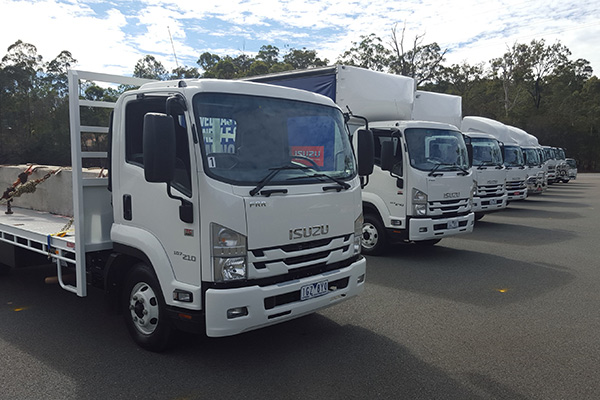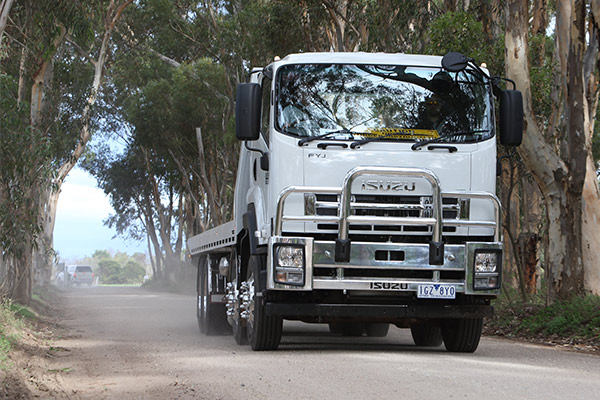Isuzu Australia’s market dominance is poised for even greater grip as its vastly refurbished medium-duty F-series trucks now hit the streets. There’s a lot to like says Steve Brooks, especially a batch of gutsy new four cylinder toilers
Writing about an Isuzu drive program isn’t always easy.
In fact, it can be decidedly difficult trying to define and describe a range of different models all assembled for a one-day ‘suck it and see’ driving event. The new F-series was no exception.
No question, this is a hugely important and all-together impressive range of new and updated medium-duty models, so it stood to reason that Isuzu would want to showcase as many versions as possible during a drive program in and around Brisbane.
Still, with eight different derivatives to drive plus a new ‘Service Pack’ model from the light-duty N-series line-up, any attempt at a detailed test report after just half an hour or so in each model would be somewhat futile.
There were, however, a few significant factors about this particular exercise that set it apart from the norm in drive days. Perhaps the most insightful was the almost total lack of mention of competitors or how the new range measures up to others.
Right now there’s no more positive example of the pressure from IAL’s internal microscope than the extraordinary success of Isuzu’s FX and FY models in 6×4 and 8×4 rigid configurations, notably in the hotly contested concrete agitator industry.
It’s no secret IAL engineers and executives nagged Japan for some time about the need for an eight-wheeler specifically designed for Australian needs and with several blue chip concrete companies now on the books, the value of that effort is undeniable.
Transmission trends
Further on market trends, there’s no escaping the fact that self-shifters of both the automated and automatic kind are today an accepted and in many cases, preferred transmission in everything from top-shelf linehaulers to ‘round-town delivery trucks.
Consequently, it was no idle coincidence that every one of the nine trucks in Isuzu’s drive program stirred through either an automated or automatic transmission.
Nor is it a secret that Isuzu has had some issues with its AMT (automated mechanical transmission) technology but on this occasion there was no hiding the intent to demonstrate the new-found smoothness and refinement of its latest AMT-TC units fitted with a torque converter function.
As for the fully automatic class, the modern-day Allison auto transmission has no peer and has a predictably strong presence in Isuzu’s new F-series family.
But so, too, does the AMT-TC, not least behind the all-new 4HK1 four cylinder engine described by Isuzu as ‘the star’ of its bigger and undeniably bolder medium-duty range.
Isuzu’s new F-series line-up. Covering all the bases.
Quick F-Series Background
We’ll get to the 4HK1 shortly but to recap on the new range first previewed just a few months back, Isuzu is quick to state its latest candidates cover more medium-duty bases than ever before.
“It is the largest range of medium-duty trucks in Australia,” said an emphatic Isuzu Australia CEO Phil Taylor.
Furthermore, Taylor points out that not only are there now around 180 specification variations across the brand’s entire light and medium-duty offerings but it also has the largest line-up of automated and automatic transmission options in the business, bar none.
Simply explained, four cylinder F-series models with gross vehicle mass (GVM) ratings between 10.7 and 14 tonnes are available with either a six-speed manual box or the six-speed AMT-TC transmission.
Meantime, most six cylinder versions offer a six-speed Isuzu manual box as standard with the option of the fully automatic Allison 2500 six-speed shifter.
The exceptions are the heavier rated FVR and FVD models which drive through either a ZF manual transmission or the Allison MD 3000 six-speed auto.
The new four-cylinder and six-cylinder engines
The six cylinder engine is the 7.8 litre 6HK1 which comes in two ratings;
- 191kW (256hp) at 2400 rpm with 761Nm (561 lb-ft) of torque from 1450 to 2400 rpm.
- 221kW (296hp) at 2400 rpm with 981Nm (724 lb-ft) of torque at 1450rpm.
The four cylinder engine displaces 5.2 litres and uses two-stage turbocharging and an intercooler to produce two performance ratings;
- 154kW (207hp) at 2400 rpm accompanied by 726Nm (535 lb-ft) of torque at 1600 rpm.
- 177kW (237hp) at 2400 rpm with 765Nm (564 lb-ft) of torque at 1600 rpm.
For emissions compliance, the 6HK1 runs an EGR system fitted with a diesel oxidation catalyst (DOC) rather than a diesel particulate filter, or diesel particulate diffuser (DPD) as Isuzu refers to it. In fact, the company asserts the 6HK1 is, ‘the only medium-duty engine in the Australian market with neither a diesel particulate filter nor SCR.’
What’s more, it is the sort of emissions technology said by Isuzu to be ‘… suited to vocational applications requiring high idle time, high PTO use and frequent stop-start duties.’
Looking down on Isuzu’s four cylinder 4HK1. “A clear leap forward in engine technology,” says Isuzu.
In other words, the DOC deletes the need for the diesel particulate regeneration process which has been problematic for Isuzu and most others in those applications unable to generate sufficient heat for the regeneration process to occur without interrupting the truck’s normal work routine.
Yet while the new 4HK1 engine does use an EGR emissions system with a diesel particulate diffuser (filter), Isuzu is entirely confident of the engine’s environmental and efficiency credentials, and critically, its ability to avoid regeneration problems.
As a company statement explains, the 4HK1 employs Isuzu’s ‘… latest diesel particulate diffuser system with a dedicated fuel injector in the manifold to take care of regenerations.’
There is, however, far more to the new engine than an enhanced emissions system which effectively meets the Japanese equivalent of Euro 6.
As IAL chief engineer Simon Humphries enthused, “There’s nothing like the 4HK1 on the medium-duty truck market today and it really marks the advent of a new generation of power plant.
“There’s clear evidence of a global trend towards lower displacement engines across the automotive world as people gravitate towards lighter, more profitable and more efficient engine technology.”
Apart from claiming high ground on the emissions front, fuel consumption was also a high priority in development of the 4HK1 according to Simon Humphries. “We have data from the Isuzu domestic market (Japan) to show the 4HK1 can deliver a seven percent overall fuel saving.
“What we’ve achieved,” he continued, “is a clear leap forward in engine technology and undeniable evidence of the trend towards higher output and lower displacement power plants.”
At this point it’s also worth pointing out that both four and six cylinder engines share the same bore and stroke dimensions which suggests that in hardware terms at least, the four is basically a shortened version of the six.
As already mentioned, each rating can be coupled to either an Isuzu six-speed manual transmission or the automated AMT-TC shifter which is the third generation of Isuzu’s automated transmission technology.
Top of the F-series family, FY eight-wheeler has been a huge success for Isuzu.
More than engines and gearboxes
Even a cursory glance at the updated F-series family reveals an impressive list of standard features which, depending on the model, range from anti-lock brakes and anti-skid regulator to a hill start aid, electric mirrors, cruise control, cornering lamps and in the case of models with the 4HK1 engine, an idle-stop system to enhance fuel economy.
Wisely, the idle-stop function can be switched on or off through a dash-mounted switch.
Testing Performance
There were three four cylinder models in the F-series drive program with GVMs from 10.7 to 11 and 12 tonnes, and according to Isuzu, all trucks in the exercise were loaded to around 80 per cent of capacity.
Again, time in each model was short and while all versions handled the event with ease, the new four cylinder versions certainly left a favourable first impression.
Hopefully, we’ll soon be able to get behind the wheel for at least a day or two for a more detailed evaluation.
For now though, I’ll just refer to a few rough notes made on the day. Take the smallest of the four cylinder models, for example, the FRR 107-210 fitted with a 10-pallet tray body: ‘Incredibly tenacious. Displays the traits of a bigger engine, digs deep and very willing to hold on down to 1,000 – 1,200rpm especially with transmission in ‘Econ’ mode.’
The same comments were equally applicable to the other two four-lungers in the line-up, namely the FRR 110-240 fitted with an eight-pallet curtain-sided body and the FSR 120-240 with a 12-pallet curtain-sider.
Fitted to all three, of course, was the AMT-TC transmission and in each example it was quickly apparent that the addition of a torque converter has made the automated shifts significantly smoother. ‘Much better than before. A really impressive bit of gear’ was the opinion noted on the day.
Actually, they’re comments equally applicable to all the F-series trucks driven on the day.
But if you think that’s the end of Isuzu’s evolution for the year, well, think again. An upgraded range of light-duty N-series trucks is just around the corner.
Isuzu has many characteristics but complacency is definitely not one of them.
Baby of the bunch is the FRR 107-210 sporting the new 4HK1 engine. Performance is strong.
Isuzu F-Series Engine Specs
Isuzu 4HK1
Type: 4 cylinder 16 valve SOHC
Displacement: 5,193 cc
Bore x Stroke: 115mm x 125mm
Power & Torque: 154kW (207hp) and 726Nm (535 lb-ft).
177kW (237-hp) and 765Nm (564 lb-ft).
Induction system: Low pressure turbocharger and high pressure Variable Geometry System (VGS) turbocharger sequentially operated and with air-to air intercooler.
Fuel injection: Direct injection high pressure common rail system. Exhaust pipe fuel injection for DPD regeneration.
Emission system: Cooled EGR with exhaust Diesel Particulate Diffuser.
Isuzu 6HK1
Type: 6 cylinder 24 valve SOHC
Displacement: 7,790 cc
Bore x Stroke: 115mm x 125mm
Power & Torque: 191kW (256hp) and 761Nm (561 lb-ft)
221kW (296hp) and 981Nm (724 lb-ft)
Induction system: Electronically controlled variable nozzle turbocharger with air-to-air intercooler.
Fuel injection: Direct injection high pressure common rail system.
Emission system: Cooled EGR with exhaust Diesel Oxidation Catalyst





